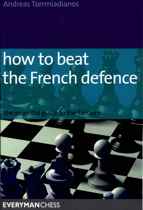How to Beat the French Defence
Andreas Tzermiadianos

Conventional wisdom holds that if White wants to play for an advantage against the French Defense, 3.Nc3 is the way to go. However, Greek IM Andreas Tzermiadianos begs to differ and makes a compelling case for the adoption of the Tarrasch variation (3.Nd2) in his new book, How To Beat The French Defence.
Tzermiadianos sees the adoption of 3.Nd2 over 3.Nc3 as a preference for a positional treatment versus a more tactical one and approximately the first 10 percent of the book (three chapters) is an overview of just why the Tarrasch is more positional. One reason, as the author makes clear, is the many different type of pawns structure that can arise from the Tarrasch from closed positions (think 3…Nf6 or 3…Nc6), to more open ones (3…c5 4.Ngf3 cxd4 5.exd5 Qxd5 and 3…dxe4) and finally isolated queen pawn ones (3…c5 4.Ngf3 Nc6 6.exd5 exd5).
How To Beat The French Defence offers a specific repertoire to combat the French that breaks down as follows:
1.e4 e6 2.d4 d5 3.Nd2
3…Nc6 4.Ngf3 Nf6 5.e5 Nd7 6.c3
3… c5 4.Ngf3 Nc6 5.exd5 exd5 6.Bb5 Bd6 7.dxc5 Bxc5 8.0-0 Nge7 9.Nb3 Bd6 10.Re1 0-0 11.Bd3
3…c5 4.Ngf3 cxd4 5.exd5 Qxd5 6.Bc4 Qd6 7.0-0 Nf6 8.Nb3 Nc6 9.Nbxd4 Nxd4 10.Nxd4 a6 11.Re1 Qc7 12.Qe2
3…Nf6 4.e5 Nfd7 5.Bd3
3…Be7 4.Bd3 c5 5.dxc5 Nf6 6.Qe2
3…dxe4 4.Nxe4 Bd7 5.c4
3…dxe4 4.Nxe4 Nd7 5.Nf3 Ngf6 6.Bd3
Some of these recommendations are main lines: for example 3…c5 4.Ngf3 Nc6 5.exd5 exd5 6.Bb5 and 3…Be7 4.Bd3 c5 5.dxc5 Nf6 6.Qe2. Here Tzermiadianos combines the organizing of important recent game citations, plenty of prose explanation and individual analysis. In other cases his choice is not quite so common, as for example his selection of 5.c4 to combat the so-called “Fort Knox variation (1.e4 e6 2.d4 d5 3.Nd2 dxe4 4.Nxe4 Bd7). Play quickly heads to relatively uncharted waters after 5…Bc6 6.Nc3 Nf6 7.Nf3 Bxf3 8.Qxf3 Nc6 9.d5 where most of the material presented is the authors analysis.
Because of the authors care in presenting lots of prose explanation of key positions and ideas, How To Beat The French Defence is quite readable despite its size and can be recommended to players of a variety of strengths from 2000 to FIDE titled players. All those who play the French seriously will want this book.
